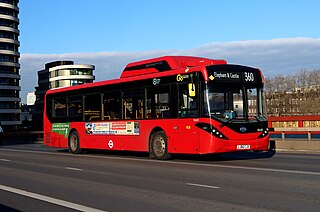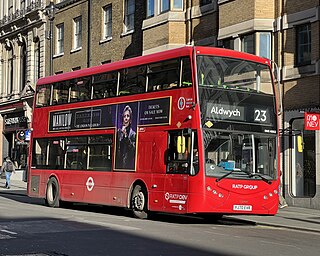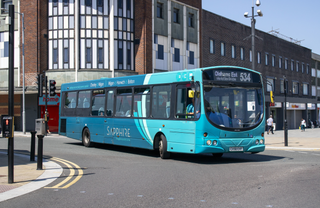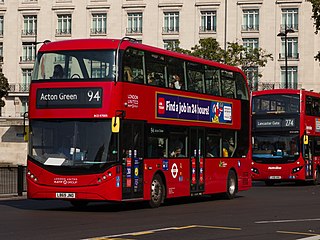
Bankside is an area of London, England, within the London Borough of Southwark. Bankside is located on the southern bank of the River Thames, 1.5 miles (2.4 km) east of Charing Cross, running from a little west of Blackfriars Bridge to just a short distance before London Bridge at St Mary Overie Dock. It is part of a business improvement district known as 'Better Bankside'.

Buses have been used as a mode of public transport in London since 1829, when George Shillibeer started operating a horse-drawn omnibus service from Paddington to the City of London. In the decades since their introduction, the red London bus has become a symbol of the city.

London Buses is the subsidiary of Transport for London (TfL) that manages most bus services in London, England. It was formed following the Greater London Authority Act 1999 that transferred control of London Regional Transport (LRT) bus services to TfL, controlled by the Mayor of London.
The Fuel Cell Bus Club comprised the participants of three demonstration projects for fuel cell buses in nine European cities and two other worldwide cities between 2001 and 2007. The Fuel Cell Bus Club became a forum to share experiences and information between cities and researchers. Other cities such as Beijing also tested buses from the consortium behind the project.

The Mercedes-Benz Citaro is a single-decker, rigid or articulated bus manufactured by Mercedes-Benz/EvoBus. Introduced in 1997, the Citaro is available in a range of configurations, and is in widespread use throughout Europe and parts of Asia, with more than 55,000 produced by December 2019.

London Buses route 12 is a Transport for London contracted bus route in London, England. Running between Dulwich Library and Oxford Circus, it is operated by London Central.

London Buses route 360 is a Transport for London contracted bus route in London, England. Running between Royal Albert Hall and Elephant and Castle, it is operated by London Central.

London Buses route 25 is a Transport for London contracted bus route in London, England. Running between Ilford and City Thameslink station, it is operated by Stagecoach London.

London Buses route 23 is a Transport for London contracted bus route in London, England. Running between Westbourne Park station and Aldwych, it is operated by London Transit.

The Wright Pulsar was a single-decker bus body built on the VDL SB200 single-decker bus chassis by Wrightbus between 2006 and 2014.

London Buses route 343 is a Transport for London contracted bus route in London, England. Running between New Cross Gate and Aldgate bus station, it is operated by London Central.

London Buses route 100 is a Transport for London contracted bus route in London, England. Running between St Paul's and Shadwell stations, it is operated by London Central.

London Buses route 141 is a Transport for London contracted bus route in London, England. Running between Palmers Green and London Bridge bus station, it is operated by Arriva London.

A fuel cell bus is a bus that uses a hydrogen fuel cell as its power source for electrically driven wheels, sometimes augmented in a hybrid fashion with batteries or a supercapacitor. The only emission from the bus is water. Several cities around the world have trialled and tested fuel cell buses, with over 5,600 buses in use worldwide, the majority of which are in China.

Articulated buses, colloquially known as "bendy buses", were rarely used in the United Kingdom compared to other countries, until the turn of the millennium. This was due to a preference for the double-decker bus for use on high capacity routes. In June 2006, there were over 500 articulated buses in the United Kingdom, although they were still heavily outnumbered by double deckers. The majority of this fleet was used in London, although these buses would be withdrawn by end of 2011.

The Bakerloo line extension is a proposed extension of the London Underground Bakerloo line in South London from its current terminus at Elephant & Castle to Lewisham station.

The New Routemaster, originally referred to as the New Bus for London and colloquially as the Borismaster or Boris Bus, is a low-floor diesel double-decker bus operated in London, England. Designed by Heatherwick Studio and manufactured by Wrightbus, it is notable for featuring a "hop-on hop-off" rear open platform similar to the original Routemaster bus design but updated to meet requirements for modern buses to be fully accessible. It first entered service in February 2012 with Arriva London on London Buses route 38.

There are 3,835 hybrid buses, 950 battery electric buses, and 20 hydrogen fuel cell buses operating in London, as of March 2023, out of a total bus fleet of 8,643 - this is around 56% of the bus fleet.

The Switch Metrodecker is an integral twin-axle double-decker bus produced by British bus manufacturer Switch Mobility since 2014. The bus bears resemblance to the Switch Metrocity, sharing similar interior and exterior features. The MetroDecker was designed as the successor to the Optare Olympus and Optare OmniDekka double-deckers, which were both discontinued in 2011, however unlike these, the MetroDecker is only available in integral form.



















